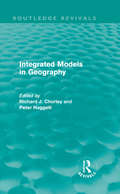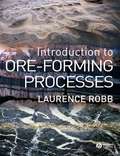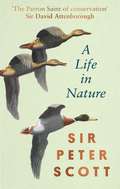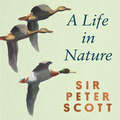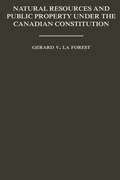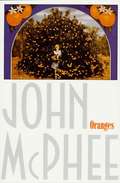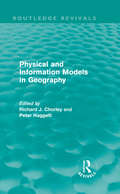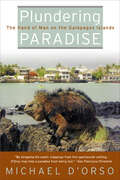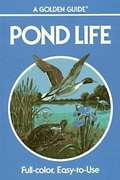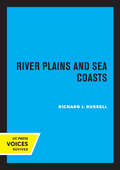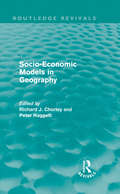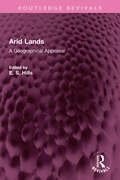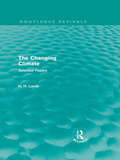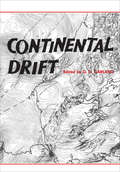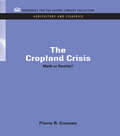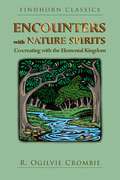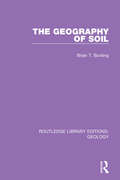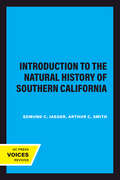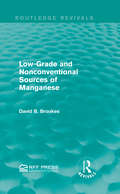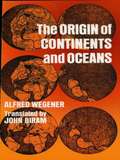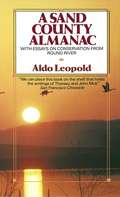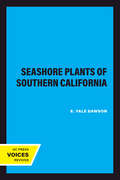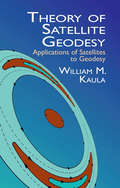- Table View
- List View
Integrated Models in Geography (Routledge Revivals)
by Richard J. Chorley Peter HaggettFirst published in 1967, this book explores the theme of geographical generalization, or model building. It is composed of five of the chapters from the original Models in Geography, published in 1967. The first chapter broadly outlines this theme and examines the nature and function of generalized statements, ranging from conceptual models to scale models, in a geographical context. The following chapters deal with mixed-system model building in geography, wherein data, techniques and concepts in both physical and human geography are integrated. The book contains chapters on organisms and ecosystems as geographical models as well as spatial patterns in human geography. This text represents a robustly anti-idiographic statement of modern work in one of the major branches of geography.
Introduction to Ore-Forming Processes
by Laurence RobbIntroduction to Ore-Forming Processes is the first senior undergraduate - postgraduate textbook to focus specifically on the multiplicity of geological processes that result in the formation of mineral deposits. Opens with an overview of magmatic ore-forming processes Moves systematically through hydrothermal and sedimentary metallogenic environments, covering as it does the entire gamut of mineral deposit types, including the fossil fuels and supergene ores The final chapter relates metallogeny to global tectonics by examining the distribution of mineral deposits in space and time Boxed examples of world famous ore deposits are featured throughout providing context and relevance to the process-oriented descriptions of ore genesis Brings the discipline of economic geology back into the realm of conventional mainstream earth science by emphasizing the fact that mineral deposits are simply one of the many natural wonders of geological process and evolution. Artwork from the book is available to instructors at www.blackwellpublishing.com/robb.
A Life In Nature
by Peter Scott'The Patron Saint of Conservation' Sir David Attenborough'Peter Scott was a huge influence on my childhood...Later on in life I had the good fortune both to meet and to interview him, and he remains, for me, a hero. His knowledge, his kindness to me and his generosity of spirit have remained an influence in my own sphere of natural history....To meet one's heroes can sometimes be a let-down. That was most certainly not the case with Peter Scott.' Alan TitchmarshA Life In Nature is a portrait of Peter Scott collected from his own conversations, articles and broadcasts including thoughts on expeditions to Lapland, Conservation and Africa, his travels in Europe and much more. Illustrated by Peter's own beautiful illustrations. Sir Peter Scott had a truly incredible life. He was the only son of legendary explorer Captain Scott. His godfather was JM Barrie and he was married to Elizabeth Jane Howard. He also represented Great Britain and Northern Ireland at sailing in the 1936 Berlin Olympic Games, winning a bronze medal. He founded the Wildfowl and Wetlands Trust and also helped to found the Worldwide Fund for Nature.This is a beautiful and timely re-discovered book, perfect for those who are interested in preserving our planet.
A Life In Nature
by Sir Peter Scott'The Patron Saint of Conservation' Sir David Attenborough'Peter Scott was a huge influence on my childhood...Later on in life I had the good fortune both to meet and to interview him, and he remains, for me, a hero. His knowledge, his kindness to me and his generosity of spirit have remained an influence in my own sphere of natural history....To meet one's heroes can sometimes be a let-down. That was most certainly not the case with Peter Scott.' Alan TitchmarshA Life In Nature is a portrait of Peter Scott collected from his own conversations, articles and broadcasts including thoughts on expeditions to Lapland, Conservation and Africa, his travels in Europe and much more. Illustrated by Peter's own beautiful illustrations. Sir Peter Scott had a truly incredible life. He was the only son of legendary explorer Captain Scott. His godfather was JM Barrie and he was married to Elizabeth Jane Howard. He also represented Great Britain and Northern Ireland at sailing in the 1936 Berlin Olympic Games, winning a bronze medal. He founded the Wildfowl and Wetlands Trust and also helped to found the Worldwide Fund for Nature.This is a beautiful and timely re-discovered book, perfect for those who are interested in preserving our planet.
A Life In Nature
by Sir Peter Scott'The Patron Saint of Conservation' Sir David Attenborough'Peter Scott was a huge influence on my childhood...Later on in life I had the good fortune both to meet and to interview him, and he remains, for me, a hero. His knowledge, his kindness to me and his generosity of spirit have remained an influence in my own sphere of natural history....To meet one's heroes can sometimes be a let-down. That was most certainly not the case with Peter Scott.' Alan TitchmarshA Life In Nature is a portrait of Peter Scott collected from his own conversations, articles and broadcasts including thoughts on expeditions to Lapland, Conservation and Africa, his travels in Europe and much more. Illustrated by Peter's own beautiful illustrations. Sir Peter Scott had a truly incredible life. He was the only son of legendary explorer Captain Scott. His godfather was JM Barrie and he was married to Elizabeth Jane Howard. He also represented Great Britain and Northern Ireland at sailing in the 1936 Berlin Olympic Games, winning a bronze medal. He founded the Wildfowl and Wetlands Trust and also helped to found the Worldwide Fund for Nature.This is a beautiful and timely re-discovered book, perfect for those who are interested in preserving our planet.
Natural Resources and Public Property Under the Canadian Constitution (The Royal Society of Canada Special Publications)
by Gerard La ForestThe controversy aroused by the Supreme Court's decision on offshore mineral rights emphsizes the importance of the public domain in the workings of the Canadian constitution. Public property is important to the provinces not only for its revenues, but also because it provides them with a powerful instrument for control of their economic and political destinies and strengthens their position in relation to federal authorities. The provisions of the British North America Act and other constitutional instruments relating to natural resources and public property are examined thoroughly in this series of lectures given to doctoral systems at the Faulte de droit of the Universite de Montreal. Professor La Forest studies ownership of mines and minerals, navigable waters, public harbours, fisheries and Indian lands, as well as the currently controversial offshore mineral rights. He notes the political imlications of the partition of proprietary rights and explores the areas of conflict between the federal and provincial governments. Also included is a discussion of the power of expropriation, and, because public property involves public monies, lending and spending powers receive attention.In these lectures, Professor La Forest traces public domain in Britain from the time when the monarch controlled all the land, to his surrender of this control to parliament in return for a civil list, and to the similar surrender to the legislatures of the British North American colonies in connection with the struggle of responsible government.The collection of lectures is essential reading for any serious student of the constitution and will be very useful to all who are interested in the increasingly important law of natural resources in Canada.
Oranges
by John McpheeA classic of reportage, Oranges was first conceived as a short magazine article about oranges and orange juice, but the author kept encountering so much irresistible information that he eventually found that he had in fact written a book. It contains sketches of orange growers, orange botanists, orange pickers, orange packers, early settlers on Florida’s Indian River, the first orange barons, modern concentrate makers, and a fascinating profile of Ben Hill Griffin of Frostproof, Florida who may be the last of the individual orange barons. McPhee’s astonishing book has an almost narrative progression, is immensely readable, and is frequently amusing. Louis XIV hung tapestries of oranges in the halls of Versailles, because oranges and orange trees were the symbols of his nature and his reign. This book, in a sense, is a tapestry of oranges, too--with elements in it that range from the great orangeries of European monarchs to a custom of people in the modern Caribbean who split oranges and clean floors with them, one half in each hand.
Physical and Information Models in Geography (Routledge Revivals)
by Richard J. Chorley Peter HaggettFirst published in 1967, this book explores the theme of geographical generalization, or model building. It is composed of eight of the chapters from the original Models in Geography, published in 1967. The first chapter broadly outlines geographical generalization and examines the nature and function of generalized statements, ranging from conceptual models to scale models, in a geographical context. The following chapter deals with model theory in a wider scientific framework and the rest of the book discusses models of physical systems and information models. The book considers model-type generalizations that are applied in the three fields of geomorphology, meteorology and climatology, and hydrology before focusing on the transference of information and ideas in geography. This text represents a robustly anti-idiographic statement of modern work in one of the major branches of geography.
Plundering Paradise: The Hand of Man on the Galapagos Islands
by Michael D'OrsoMention the Galápagos Islands to almost anyone, and the first things that spring to mind are iguanas, tortoises, volcanic beaches, and, of course, Charles Darwin. But there are people living there, too -- nearly 20,000 of them. A wild stew of nomads and grifters, dreamers and hermits, wealthy tour operators and desperately poor South American refugees, these inhabitants have brought crime, crowding, poaching, and pollution to the once-idyllic islands. In Plundering Paradise, Michael D'Orso explores the conflicts on land and at sea that now threaten to destroy this fabled "Eden of Evolution."
Pond Life
by George Reid Herbert Zim Sally Kaicher Tom DolanA handbook describing and illustrating some of the common animals and plants found in or near ponds, lakes, streams, and marshes.
River Plains and Sea Coasts
by Richard J. RussellThis title is part of UC Press's Voices Revived program, which commemorates University of California Press’s mission to seek out and cultivate the brightest minds and give them voice, reach, and impact. Drawing on a backlist dating to 1893, Voices Revived makes high-quality, peer-reviewed scholarship accessible once again using print-on-demand technology. This title was originally published in 1967.
Socio-Economic Models in Geography (Routledge Revivals)
by Richard J. Chorley and Peter HaggettFirst published in 1968, this book explores the theme of geographical generalization, or model building. It is composed of seven of the chapters from the original Models in Geography, published in 1967. The first chapter broadly outlines this theme and examines the nature and function of generalized statements, ranging from conceptual models to scale models, in a geographical context. The following six chapters deal with socio-economic building in geography. They focus on demographic and sociological models as well as looking at special aspects of models in human geography in reference to economic development, urban geography and settlement location, industrial location, and agricultural activity. This book represents a robustly anti-idiographic statement of modern work in one of the major branches of geography.
Waves
by Herbert S. ZimThis book talks about anything you ever wanted to know about waves, from how they are formed, explaining simple vocabulary about waves, how they travel across the oceans, how they can be destructive, and how they can be useful too. Although this book was published in 1967 I found it had some excellent information on a topic not often talked about, Ocean waves. Good read in my opinion.
Arid Lands: A Geographical Appriasal (Routledge Revivals)
by E. S. HillsIn 1951 UNESCO launched an Arid Zone Programme with the object of promoting research into arid regions from every relevant scientific point of view. This book, originally published in 1966, represents the range of research undertaken and gives a general conspectus of arid zone geography. 17 authors from 8 countries contributed and the book deals comprehensively with all the main areas, with specific examples used to illustrate arguments. There are chapters on meteorology, geology, geomorphology, botany and zoology and almost 50% of the book is devoted to man’s activities: irrigation and agriculture; industry; animal breeding and human survival in the desert
The Changing Climate: Selected Papers (Routledge Revivals: A History of Climate Changes)
by H. H. LambFirst published in 1966 these collected papers, written by the distinguished and visionary climatologist Hubert H. Lamb, describe how climates come about and give a history of climatic changes from the last ice-age to the 1960s.
Continental Drift
by G. D. GarlandThe possibility that the continents of the earth have undergone major changes in position during the earth's history has fascinated scholars for at least three hundred years. Recently, evidence from several scientific disciplines has shown that the possibility must be very seriously considered in any study of the surface features of the earth. The first part of this volume consists of papers given at a symposium on continental drift, held at the annual meeting of the Royal Society of Canada in Charlottetown in June 1964. They present the views of three geophysicists, a botanist, and an astronomer. In these papers, the present evidence for or against continental drift is reviewed and the authors in most cases draw their own conclusions. The reader will find that there is not unanimous agreement in favour of drift. Nearly all discussions of continental drift stress the possible separation of the Americas from Europe and Africa. Considerable work has been done on the tracing of structures, on each side of the Atlantic Ocean, which might once have been connected. Geologists and geophysicists working in the Arctic or on the eastern seaboard of Canada have an important contribution to make to this subject. The second part of this volume, therefore, consists of a group of papers, also presented at the Charlottetown meeting, which throw light on the complicated crustal structure of these regions. In any attempt to reconstruct North America as part of Europe the features described in these papers will have to be taken into account. Once again, the reader will find differences of opinion on the question of whether the evidence favours a separation of our continent from Europe. Indeed, it is because the theory of continental drift us so difficult to confirm without ambiguity by direct observation that it remains controversial but exciting.
The Cropland Crisis: Myth or Reality? (RFF Agriculture and Fisheries Set)
by Pierre CrossonThis book examines the factors affecting the demand for agricultural land in the United States and the costs of meeting increasing demand. Originally published in 1982
Encounters with Nature Spirits: Co-creating with the Elemental Kingdom
by R. Ogilvie CrombieA fascinating, first-hand account of the vast powers and true nature of the Elemental Kingdom • Reveals deep wisdom, eloquently shared through the author’s encounters with the great God Pan and his elemental subjects • Offers a glimpse into the hidden layers of the natural world and the workings of the elemental kingdom • Includes chapters by Mike Scott, David Spangler, Dorothy Maclean, and Brian Nobbs as well as beautiful illustrations by fine artist Elise Hurst, who perfectly captures the energy of the natural world and its subjects as we might perceive them “To anyone who may have expressed a wish to see and talk to nature spirits . . . remember it took 63 years for my wish to be granted, so don’t lose hope.” Have you ever wished for something with your whole heart? As a child, R. Ogilvie Crombie (Roc) made a wish as he dropped a penny into a wishing well - he asked to be able to see fairies and talk to them. In Encounters with Nature Spirits, we follow Roc’s path as, many years later, he meets the faun Kurmos in the Royal Botanic Garden in Edinburgh, discovers the realm of the elementals, and, eventually, meets the great god Pan himself. In his conversations with Pan, elves, and other nature spirits Roc realizes that the elemental realm is vastly more powerful than our human kingdom and possesses an ability to create far beyond our human means. Through his experiences Roc becomes closely involved with the Findhorn Community in northeast Scotland where he meets further elementals who give him sound advice as to how the famous Findhorn gardens should be cared for in order to work in harmony with nature. Encounters with Nature Spirits is a reminder to us all of the importance of our relationship with the nature kingdom. Through his example, Roc places emphasis on connecting and working in harmony with nature spirits. True co-creation with nature, working with rather than against the elemental kingdom, can bring about vital positive change to our endangered eco-system. The elementals are open to working with mankind--the question is, are we humans open to engaging with and respecting them again?
The Geography of Soil (Routledge Library Editions: Geology #10)
by Brian T. BuntingThis book, first published in 1965, was the first by a British soil expert in which he wrote a study of his subject from a geographical, not an agricultural or biological, viewpoint. Chapters 1-8 deal with the factors and processes in soil formation. Chapters 9-17 describe the soil groups of the different regions of the world – for example, desert and tundra, the boreal zone, the Mediterranean, and intertropical areas.
Introduction to the Natural History of Southern California (California Natural History Guides #13)
by Edmund C. Jaeger Arthur C. SmithThis title is part of UC Press's Voices Revived program, which commemorates University of California Press’s mission to seek out and cultivate the brightest minds and give them voice, reach, and impact. Drawing on a backlist dating to 1893, Voices Revived makes high-quality, peer-reviewed scholarship accessible once again using print-on-demand technology. This title was originally published in 1966.This title is part of UC Press's Voices Revived program, which commemorates University of California Press’s mission to seek out and cultivate the brightest minds and give them voice, reach, and impact. Drawing on a backlist dating to 1893, Voices Revived</DIV
Low-Grade and Nonconventional Sources of Manganese (Routledge Revivals)
by David B. BrookesThis book, first published in 1966, reports the results of a pilot study devoted to understanding the middle-term resource situation for one metal – manganese. Two factors bring the different parts of the manganese supply-demand picture together, one economic and the other political, both of which are examined in detail in this report. Low-Grade and Nonconventional Sources of Manganese will be of interest to students of environmental studies.
The Origin of Continents and Oceans
by Alfred WegenerSince its inception modern geology has been faced with an important group of problems: explaining parallel formations that are separated by great distances of sea; accounting for isolated life forms in widely separated areas (such as lemurs in Madagascar and India); explaining pre-pleistocene glaciations, and similar problems. The usual explanation has been to assume the one-time existence of land bridges (such as the hypothetical Lemuria) or parallelisms or diffusion with lost intermediary steps.In 1915, however, one of the most influential and most controversial books in the history of science provided a new solution. This was Alfred Wegener's Entstehung der Kontinente, which dispensed with land bridges and parallel evolutions and offered a more economical concept. Wegener proposed that in the remote past the earth's continents were not separate (as now), but formed one supercontinent which later split apart, the fragments gradually drifting away from one another. Wegener created his supercontinent with attractive simplicity by tucking the point of South America into the Gulf of Guinea, coalescing North America, Greenland, and Europe, rotating Australia and Antarctica up through the Indian Ocean, and closing the remaining gaps. Wegener then explained various phenomena in historical geology, geomorphy, paleontology, paleoclimatology, and similar areas of science in terms of this continental drift. To back up his revolutionary theory he drew upon a seemingly inexhaustible find of data. Later editions of his book added new data to refute his opponents or to strengthen his own views in the violent scientific quarrel that arose.Even today this important question remains undecided, and geologists are divided into strongly opposed groups about the Wegener hypothesis. At the moment it seems to be gaining steadily in acceptance. It is one of the two basic theories of earth history, and since it has often been misrepresented in summary, every earth scientist owes it to himself to examine its theories and data.
Sand County Almanac (With Essays On Conservation From Round River)
by Aldo Leopold Carolyn Clugston Leopold Luna Berger Leopold"We can place this book on the shelf that holds the writings of Thoreau and John Muir. " San Francisco Chronicle These astonishing portraits of the natural world explore the breathtaking diversity of the unspoiled American landscape -- the mountains and the prairies, the deserts and the coastlines. A stunning tribute to our land and a bold challenge to protect the world we love.
Seashore Plants of Southern California (California Natural History Guides #19)
by E. Yale DawsonThis title is part of UC Press's Voices Revived program, which commemorates University of California Press’s mission to seek out and cultivate the brightest minds and give them voice, reach, and impact. Drawing on a backlist dating to 1893, Voices Revived makes high-quality, peer-reviewed scholarship accessible once again using print-on-demand technology. This title was originally published in 1966.This title is part of UC Press's Voices Revived program, which commemorates University of California Press’s mission to seek out and cultivate the brightest minds and give them voice, reach, and impact. Drawing on a backlist dating to 1893, Voices Revived</DIV
Theory of Satellite Geodesy: Applications of Satellites to Geodesy (Dover Earth Science)
by William M. KaulaThe main purpose of this classic text is to demonstrate how Newtonian gravitational theory and Euclidean geometry can be used and developed in the earth's environment. The second is to collect and explain some of the mathematical techniques developed for measuring the earth by satellite.Book chapters include discussions of the earth's gravitational field, with special emphasis on spherical harmonies and the potential of the ellipsoid; matrices and orbital geometry; elliptic motion, linear perturbations, resonance, and other aspects of satellite orbit dynamics; the geometry of satellite observations, including time and precise definition of coordinates, and observability conditions; and statistical implications and date analysis.The completion of a first-year course in physics and a first-year course in calculus is assumed.
